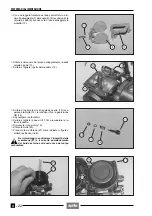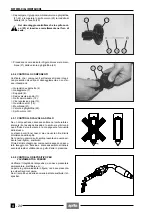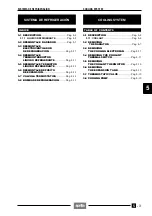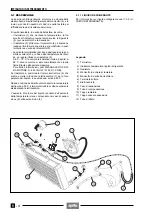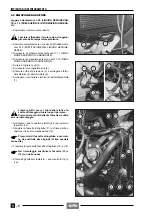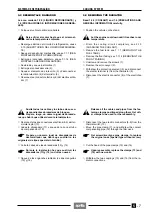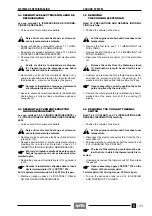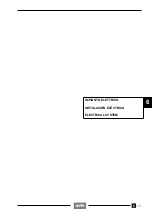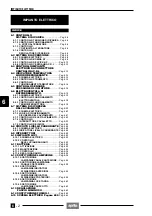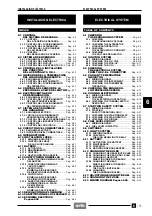
5
- 5
SISTEMA DE REFRIGERACIÓN
COOLING SYSTEM
5.1 DESCRIPCION
La bomba centrífuga (interior al motor y accionada por el
mismo) aspira el líquido refrigerante del manguito (5), y lo
envía a través de los conductos colocados en el cilindro y
en la culata para enfriar las partes del motor que se han
sobrecalentado.
El líquido caliente, al salir de la culata, encuentra :
– El termistor (1) que registra la temperatura y la tran-
smite al indicador temperatura líquido refrigerante (2)
(en el salpicadero) que la visualiza.
– El radiador (3), a través del manguito (4), el líquido
ocupa antes su mitad superior y luego se vierte en la
parte inferior saliendo sucesivamente del manguito (5).
– La válvula termostática (del tipo de pastilla de cera
sensible al calor) la cual, según la temperatura del
líquido, regula el flujo en el radiador (3).
A los 60˚-70˚ la válvula termostática empieza a abrirse,
a unos 85˚ la válvula se abre del todo y deja salir el
líquido a su máximo caudal.
Para más informaciones, véase el MANUAL DE TAL-
LER MOTOR, N˚ 933 (D-UK)/ N˚ 934 (I-E-F).
Sobre el radiador está colocado el termointerruptor (6)
que se acciona y pone en función el electroventilador (7),
si la temperatura del líquido en esta zona llega a los
90˚C.
Cuando, por medio de la acción del electroventilador, la
temperatura del líquido alcanza los 80˚C, el termointe-
rruptor se pone en función otra vez desconectando el
electroventilador.
El aumento del volumen del líquido (debido al incremento
de la temperatura) se compensa en el depósito de ex-
pansión (8), mediante el tubo (9).
5.1.1 LIQUIDO REFRIGERANTE
Para informaciones sobre el líquido refrigerante, véase
1.2.5 (LÍQUIDO REFRIGERANTE).
Pie de la ilustración:
1) Termistor
2) Indicador temperatura del líquido refrigerante
3) Radiador
4) Manguito en entrada al radiador
5) Manguito de salida del radiador
6) Termointerruptor
7) Electroventilador
8) Depósito de expansión
9) Tubo de compensación
10) Tapón radiador
11) Tapón depósito de expansión
12) Tubo de purga
5.1 DESCRIPTION
The centrifugal pump (positioned inside the engine and
driven by this latter) draws coolant from the coupling (5)
and distributes it to the galleries in the cylinder and in the
head, in order to cool the overheated parts of the engine.
The warmed liquid that comes out of the head meets:
– Ehe thermistor (1) that takes its temperature and tran-
smits the relevant value to the coolant temperature in-
dicator (2) (on the dashboard) that displays it.
– The radiator (3) through the coupling (4): the fluid first
occupies its upper part and then flows to the lower part
and out of the coupling (5).
– The thermostatic valve (type with heat-sensitive wax)
that, according to the coolant temperature, regulates its
flow into the radiator (3).
At 60˚ - 70˚C the thermostatic valve starts opening; at
about 85˚C it opens completely and lets the fluid flow
with maximum delivery.
For further information, see the ENGINE SERVICE
MANUAL, n. 933 (D-UK) / n. 934 (I-E-F).
The radiator is provided with the thermal switch (6), which
snaps and operates the electrofan (7) if the liquid temper-
ature in this area reaches 90˚C.
When the operation of the electrofan brings the coolant
temperature back to 80˚C, the thermal switch snaps
again and disconnects the electrofan.
The coolant volume increase (caused by the temperature
increase) is compensated for in the expansion tank (8),
through the pipe (9).
5.1.1 COOLANT
For any information regarding the coolant, see 1.2.5
(COOLANT).
Key:
1) Thermistor
2) Coolant temperature indicator
3) Radiator
4) Coupling to radiator
5) Coupling from radiator
6) Thermal switch
7) Electrofan
8) Expansion tank
9) Coolant compensating pipe
10) Radiator plug
11) Expansion tank plug
12) Breather pipe
Содержание Pegaso 650
Страница 1: ......
Страница 3: ...0 4 NOTE NOTES ANMERKUNGEN ...
Страница 4: ...1 1 1 2 3 4 5 6 7 8 INFORMAZIONI GENERALI INFORMACIONES GENERALES GENERAL INFORMATION ...
Страница 42: ......
Страница 69: ...3 1 1 2 3 4 5 6 7 8 MOTORE MOTOR ENGINE ...
Страница 90: ...3 22 MOTORE NOTE NOTAS NOTES ...
Страница 91: ...4 1 1 2 3 4 5 SISTEMA DI ALIMENTAZIONE SISTEMA DE ALIMENTACIÓN FUEL SYSTEM ...
Страница 116: ...4 26 SISTEMA DI ALIMENTAZIONE NOTE NOTAS NOTES ...
Страница 117: ...5 1 1 2 3 4 5 6 7 8 IMPIANTO DI RAFFREDDAMENTO SISTEMA DE REFRIGERACIÓN COOLING SYSTEM ...
Страница 130: ...5 14 IMPIANTO DI RAFFREDDAMENTO SISTEMA DE REFRIGERACIÓN COOLING SYSTEM NOTE NOTAS NOTES ...
Страница 131: ...6 1 6 1 2 3 4 5 6 7 8 IMPIANTO ELETTRICO INSTALACIÓN ELÉCTRICA ELECTRICAL SYSTEM ...
Страница 176: ...IMPIANTO ELETTRICO INSTALACIÓN ELÉCTRICA ELECTRICAL SYSTEM 6 46 NOTE NOTAS NOTES ...
Страница 177: ...7 1 1 2 3 4 5 6 7 8 CICLISTICA PARTE CICLO CHASSIS PARTS ...
Страница 226: ... 67 3 57 2 66 6 3 576 7 50 5827 3267 5 25 58 75 6 5 5 5 ...
Страница 242: ... 67 3 57 2 66 6 3 576 7 66 5 12 17 5 25 5 12 17 52 5217 5 ...
Страница 246: ... 67 3 57 2 66 6 3 576 7 70 5 12 3267 5 25 5 12 75 6 52 5 5 5 ...
Страница 272: ... 67 3 57 2 66 6 3 576 7 96 NOTE NOTAS NOTES ...
Страница 273: ...8 1 1 2 3 4 5 6 7 8 INFORMAZIONI PER LE RIPARAZIONI INFORMACIONES PARA LAS REPARACIONES REPAIRS ...
Страница 301: ...INFORMAZIONI PER LE RIPARAZIONI INFORMACIONES PARA LAS REPARACIONES REPAIRS 8 29 E F E F G H G H ...
Страница 302: ...INFORMAZIONI PER LE RIPARAZIONI INFORMACIONES PARA LAS REPARACIONES REPAIRS 8 30 I L I M L N M N ...
Страница 303: ...INFORMAZIONI PER LE RIPARAZIONI INFORMACIONES PARA LAS REPARACIONES REPAIRS 8 31 O P Q P O R Q R ...
Страница 310: ...INFORMAZIONI PER LE RIPARAZIONI INFORMACIONES PARA LAS REPARACIONES REPAIRS 8 38 NOTE NOTAS NOTES ...
Страница 311: ...INFORMAZIONI PER LE RIPARAZIONI INFORMACIONES PARA LAS REPARACIONES REPAIRS 8 39 ...






